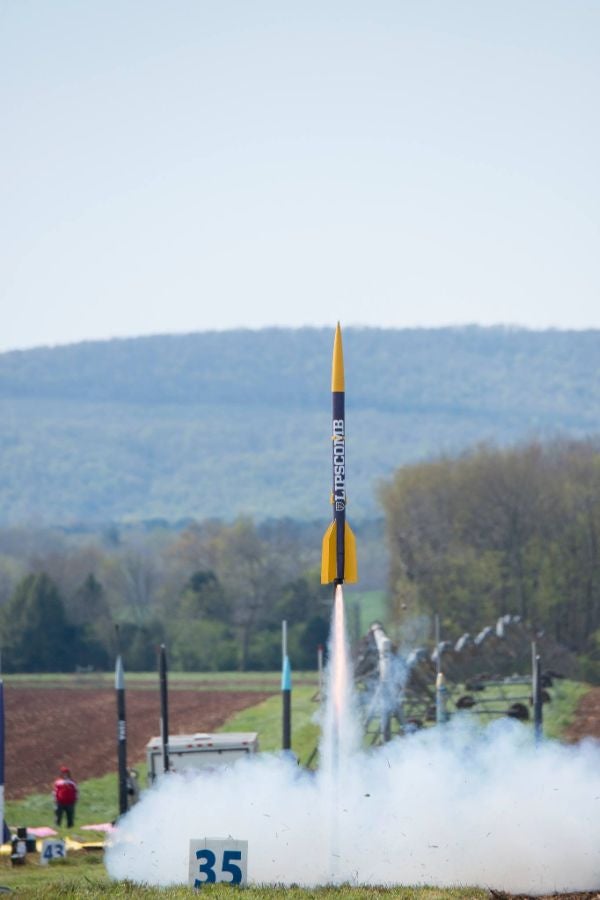Rocket team has successful rocket launch at 2018 NASA student event in Huntsville
Tristan Brew |
 Just one month before NASA sends millions of people’s submitted names aboard its InSight Lander that will travel to Mars on May 5, Lipscomb University’s rocket team launched a rocket of its own.
Just one month before NASA sends millions of people’s submitted names aboard its InSight Lander that will travel to Mars on May 5, Lipscomb University’s rocket team launched a rocket of its own.
Earlier this month, the rocket team, comprised of students in the Raymond B. Jones College of Engineering, participated in NASA’s 2018 student rocket launch, near NASA’s Marshall Space Flight Center in Huntsville, Alabama.
The team, made up of five mechanical engineering students and two electrical engineering students, is led by Joseph Tipton, associate professor of mechanical engineering and department chair. Last fall, the team submitted its proposal to the NASA student launch project office in Huntsville and the proposal was accepted in October after two weeks of waiting.
Throughout the development of the rocket, the team was advised by several engineering faculty members including Tipton and David Davidson, professor of practice and civil engineering. Tipton suggested that his students enter the competition and asked them to consider it as a potential senior capstone design project. Students who were part of the team include mechanical engineering students Austin Brown, Caleb Davenport, Jericho Locke, Caleb Stubbs and Taylor Wright and electrical and computer engineering students Jeffrey Gage and Ryan Seal.
The seniors on the team are taking part in the launch as a course requirement for graduation and the course catalog describes the project as "major, realistic design experience based on the knowledge and skills acquired in prior and concurrent course work, and requiring teamwork involving more than one discipline."
"The team came into the project with virtually no previous rocketry experience, so we each learned an incredible amount simply in terms of technical aspects of rocketry," said Locke, a senior who will work as a science policy fellow for the Science and Technology Policy Institute in Washington, D.C., following graduation in May. "However, just as senior design projects are designed, the important part isn't really learning the technical ability but learning how to be an engineer and complete complex projects. This was certainly a complex project; it was eight months following a prototypical NASA design process and the prototypical NASA amount of paperwork (by the end we will have submitted almost 700 pages worth of polished reports). We worked how to solve hard problems, work in an interdisciplinary team, stick to a budget, and most other major areas that I would expect to see in a post-grad project. As the team leader, I learned a lot about managing a project and leadership that I will not soon forget."
Tipton agreed that the experience is valuable at many levels for students.
“This is a chance for the students on the team to work on an open-ended engineering project. They have had to manage a complex schedule, work as a team across several fields of specialization, and communicate technical information orally and in writing,” Tipton said.
While the team did not have to participate in any preliminary competitions in order to take part in this year’s launch, the team conducted a subscale launch in early January and a full scale test launch at an approved launch site in Talladega, Alabama, on Feb. 17 prior to the April competition.
Tipton and his students faced some exceptional competitors at the April event as over 60 academic institutions participated in the four-day NASA-sponsored event.
“Being selected for a prestigious competition such as NASA’s student rocket launch validated to our team that Lipscomb is able to provide just as good of an education as much larger and older ‘State U’ engineering programs,” said Tipton. “The competition is over a decade old, and a lot of teams present at the competition were able to build upon many years of experience. I'm very proud of our team considering our department has never done something like this before and how they were able to complete all aspects of the year-long competition.”
Locke said the Lipscomb team was one of the smallest in the competition but scored well above average on their design reporters. He said they also worked with their industry sponsor, Jacob Engineering, both for funding and mentorship throughout the process.
To learn more about the Raymond B. James College of Engineering at Lipscomb University and why they were named one of the best Christian-based engineering programs in Tennessee and number six in the nation in a survey by Christian Universities Online, visit engineering.lipscomb.edu.
To learn more about NASA’s Student Launch challenge, visit http://www.nasa.gov/education/studentlaunch.
—Photos submitted by Jericho Locke